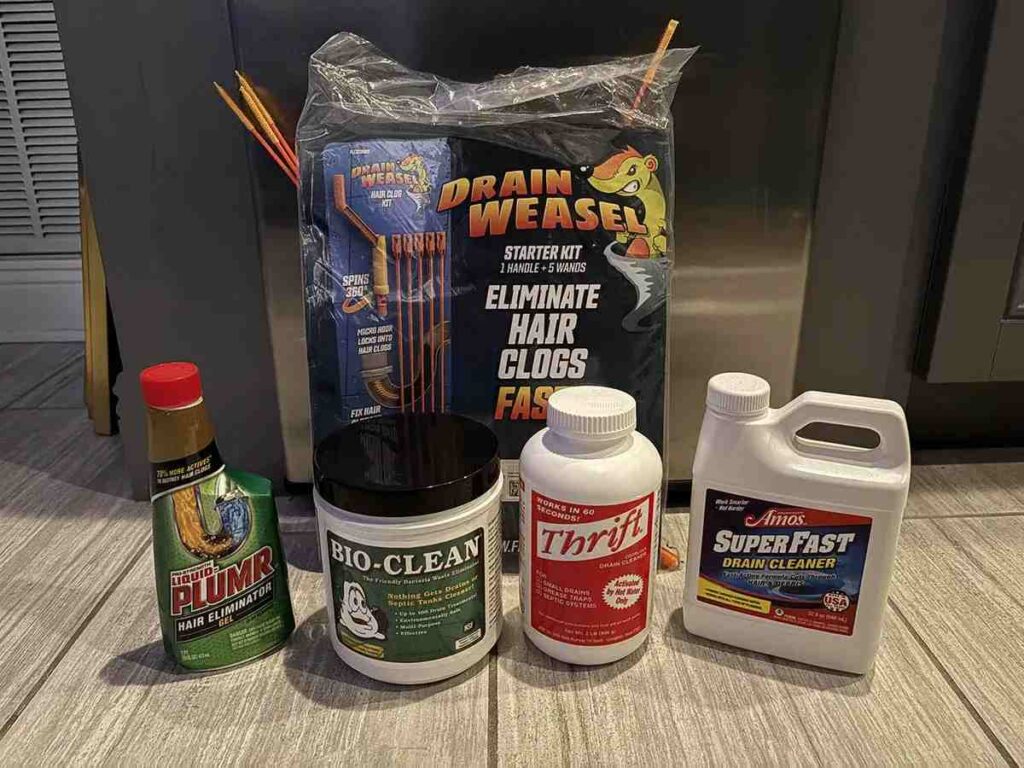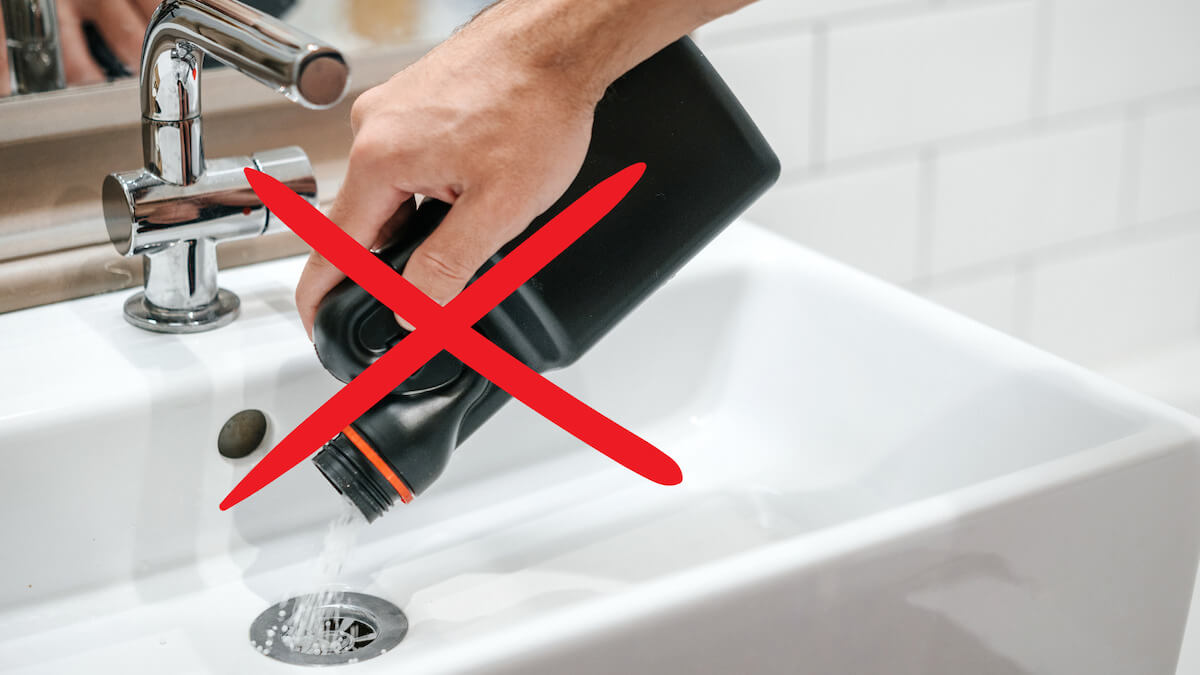When your sink backs up or your tub won’t drain, your first instinct might be to grab a bottle of liquid drain cleaner from the hardware store. After all, it seems quick, easy, and cost-effective. But here’s the truth: those short-term fixes can lead to long-term damage—to your plumbing system, your health, and even the environment.
At PlumbingAmarillo.us, we’ve seen firsthand what happens when homeowners over-rely on commercial drain cleaning chemicals instead of calling a professional drain cleaning plumber. Let’s break down why you should think twice before using those chemical solutions—and what you should do instead.
What’s in That Bottle?

Most drain cleaner solutions contain extremely corrosive substances like hydrochloric acid, sodium hydroxide, or potassium hydroxide—also known as caustic potash or lye. These powerful chemicals, often referred to by hyponyms like drain acid, are designed to break down organic matter fast. While that might sound like the ideal clog remover, it’s far from safe.
These chemicals generate an exothermic reaction (meaning they produce heat), which can warp PVC pipes and corrode metal piping. If you’re wondering, “Does drain cleaner damage pipes?” — the answer is a firm yes, especially if used repeatedly or left sitting overnight.
How Do Drain Cleaners Work?

Commercial liquid drain openers like Drano, Liquid-Plumr, or Liquid Lightning work by attempting to dissolve clogs made of hair, grease, or organic waste. Some formulations like hair and grease drain opener use thick gels (like Forid drain gel cleaner) that are supposed to cling to clogs. However, many DIY users ask, “Does drain cleaner actually work?“
Often, it doesn’t. Especially for severe blockages, foreign objects, or tree root intrusions, no amount of drain gel will help. Instead, you’ll be left with a toxic mess that still requires a professional plumber to clean up.
The Costly Consequences of DIY Drain Cleaners
1. Pipe Damage
One of the biggest dangers of using a drain cleaner acid like muriatic acid or Drano Max Gel is its heat. While metal pipes may endure short exposures, repeated use weakens the integrity of your pipes. Plastic pipes can melt or deform, causing expensive repairs or even full pipe replacement.
Older homes with vintage piping should be especially cautious. If you’re wondering about the best drain cleaner for old pipes, the answer is usually: none. Instead, opt for a plumber drain cleaning service using safer, non-invasive methods like hydro jetting (which we perform safely on all pipe types).
2. Health Hazards
The fumes from chemical drain cleaners can irritate your eyes, throat, and lungs. Accidental skin or eye contact can result in severe chemical burns. The term drain cleaner safety exists for a reason—it’s a genuine concern. That’s why we strongly recommend avoiding these solutions unless you’re trained in handling hazardous materials.
3. Environmental Harm
Most commercial drain cleaners end up washed into municipal water systems, rivers, and streams. This leads to water contamination and harm to aquatic life. Even worse, mixing these chemicals with other household cleaners—such as bleach or ammonia—can cause toxic gas formation, a significant safety risk.
Better (and Safer) Alternatives to Liquid Drain Cleaners
Instead of risking your health and plumbing, here are safe and effective alternatives you can try at home:
- Baking Soda and Vinegar: A natural chemical reaction occurs when you mix equal parts (½ cup each) of baking soda and white vinegar, followed by hot water. This is one of the most effective non-toxic drain cleaners available.
- Baking Soda and Salt: A similar DIY method that creates a milder chemical reaction to help dissolve minor clogs.
- Hot Water and Dish Soap: This combo breaks down grease build-up and is gentle on pipes—an ideal solution for sink drain liquid cleaning.
- Manual Tools: Use a plunger or a drain snake for minor clogs. Or try a drain cleaning bladder that connects to a garden hose and uses water pressure to flush the clog.
But when these methods don’t work, or the clog keeps coming back, it’s time to call the pros.
Why Call PlumbingAmarillo.us?
At PlumbingAmarillo.us, we offer professional drain cleaning and clog removal services that are safer, more effective, and longer-lasting than any store-bought solution.
- We use diagnostic tools like drain cameras to locate the blockage precisely.
- Our team is trained in safe chemical alternatives and eco-friendly practices.
- We specialize in drain unclogging, pipe cleaning, and whole-house drain cleaning, ensuring your system is running smoothly without harm.
Whether you’re dealing with a stubborn clog, an emergency backup, or simply want to maintain your drains with a commercial drain maintenance plan, we’re your trusted local experts. Don’t rely on drain chemical cleaners that could do more harm than good.
👉 Explore our Drain Cleaning Services
👉 Need a camera inspection? See our Drain Survey Services
👉 Have a bigger issue? We also offer Sewer Cleaning and Repair
Final Thoughts: Is Drain Cleaner Worth It?
So, is drain cleaner safe for pipes? Not usually.
Does Drano damage pipes? Yes.
Is Liquid-Plumr bad for pipes? Also yes.
At best, chemical drain cleaners offer a temporary fix. At worst, they cause thousands in damages. It’s time to leave the bottle on the shelf and trust real plumbing solutions.
Avoid risky quick-fixes and call the experts at PlumbingAmarillo.us—we don’t just unclog pipes; we restore your peace of mind.
Looking for the safest, most effective way to clean your drains? Contact PlumbingAmarillo.us today for fast, friendly, and professional service. Let us help you flush your plumbing worries away—without the burn.



